10 International Breakfast Foods That Define Culture

Have you ever wondered what a morning meal can reveal about a country’s culture? From bustling cafés to family kitchens, breakfast goes beyond nutrition; it’s a reflection of history, geography, and lifestyle. International breakfast foods showcase the diversity of culinary traditions and how people start their day around the world.
Let’s explore 10 iconic breakfasts and the cultural stories they tell.
1. Turkish Breakfast – Kahvaltı
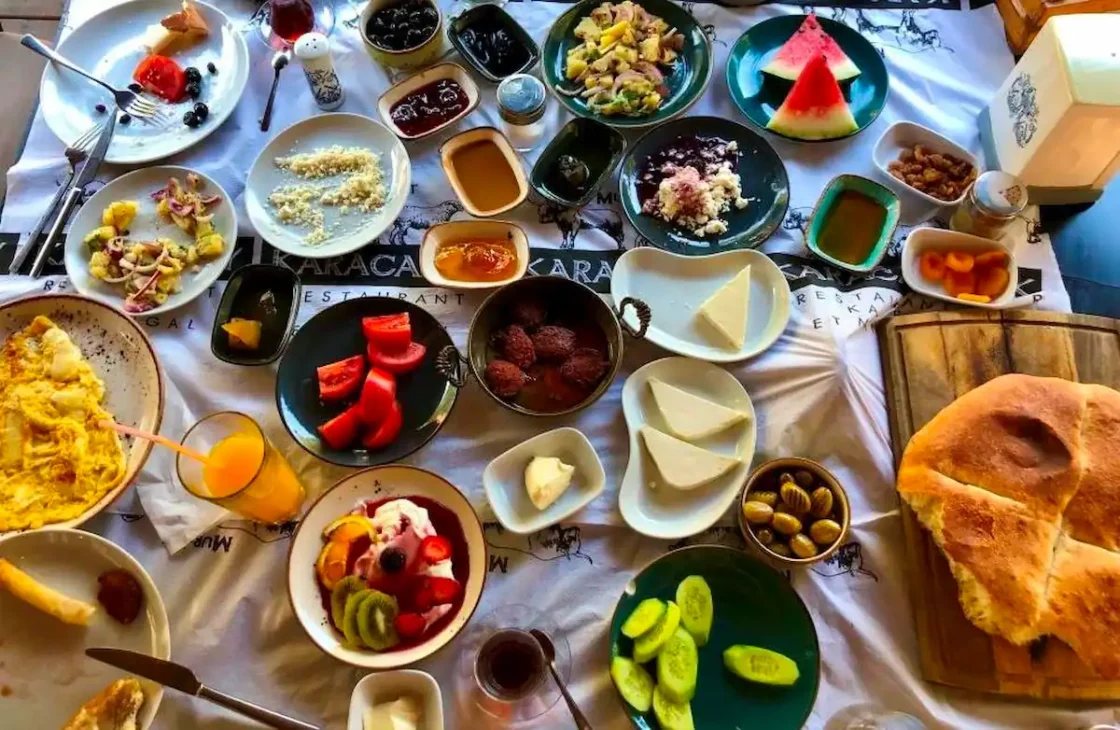
Kahvaltı, literally meaning “before coffee,” is Turkey’s traditional morning meal, commonly enjoyed at home or in local cafés, particularly in Istanbul and along the Aegean and Mediterranean coasts. A classic table features regional specialties such as simit (sesame-crusted bread rings), pide (soft flatbread), beyaz peynir (white brined cheese), along with olives, tomatoes, cucumbers, honey, jam, eggs, and strong Turkish tea, creating a colorful and flavorful spread.
Rooted in centuries of Anatolian customs, kahvaltı highlights fresh, locally sourced produce and dairy, celebrating Turkey’s agricultural richness while providing nourishment for the day ahead.
More than just food, kahvaltı serves as a space for conversation, warmth, and connection among family and friends. Sharing the table fosters a relaxed start to the day, reinforcing a sense of community and the cultural value of togetherness.
2. English Breakfast – Full English

The Full English Breakfast, affectionately known as a “fry-up,” is England’s quintessential morning feast. It is enjoyed in homes, cafés, hotels, and pubs across the UK, particularly in London, the Midlands, and Northern England. A typical plate includes eggs, back bacon, sausages, baked beans, grilled tomatoes, mushrooms, toast, and sometimes black pudding or hash browns.
This hearty breakfast traces its roots to Victorian times, when working families required a filling start to long, labor-intensive days. Originally, it was a lavish spread served by the aristocracy, showcasing meats, breads, and preserves as a display of wealth and hospitality. As food became more accessible, the Full English evolved into a practical, sustaining meal. Cafés and “greasy spoon” diners further popularized it, embedding this breakfast into everyday British life.
More than just food, the Full English Breakfast symbolizes tradition, comfort, and shared ritual. While weekday versions have become lighter or quicker, it remains a celebratory weekend indulgence for many, evoking nostalgia and connections to past generations.
3. Japanese Breakfast – Asagohan
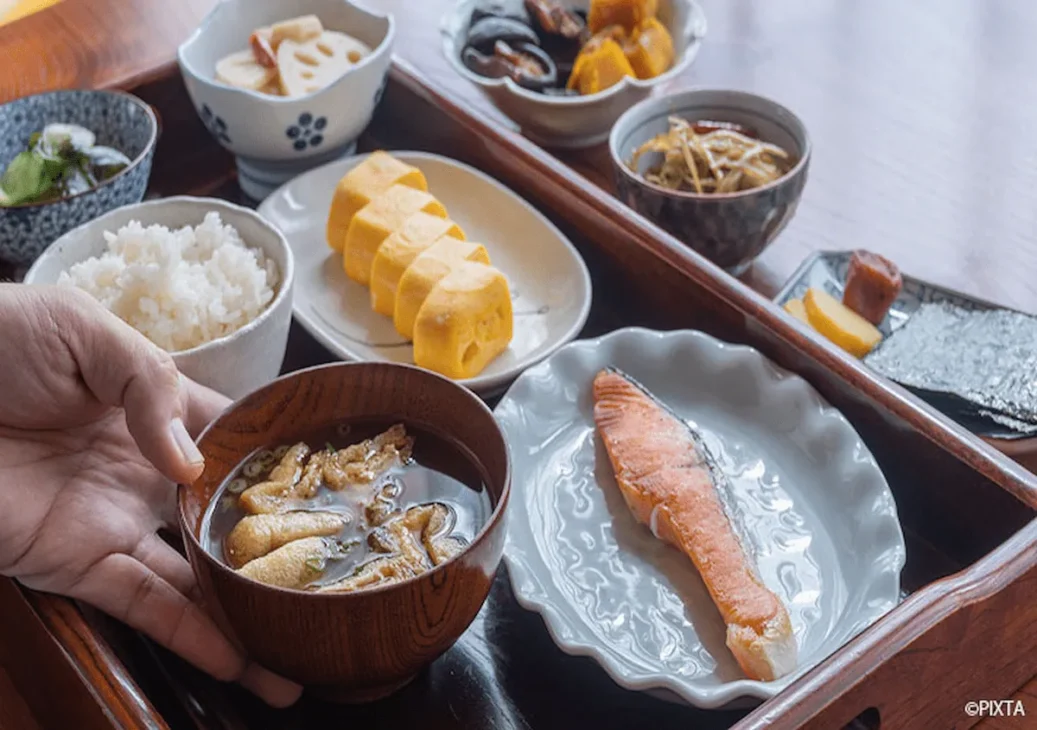
Asagohan, which translates to “morning rice,” is Japan’s traditional breakfast. It is typically enjoyed at home, in ryokan (traditional inns), or at local eateries across the country. A classic asagohan includes steamed white rice, miso soup, grilled fish, pickles, and nori (seaweed). This combination creates a harmonious balance of flavors, textures, and nutrients, offering both nourishment and a gentle start to the day.
The origins of asagohan date back to the Edo period (1603–1868), when Japanese breakfasts became more structured and nutritionally balanced. Rice, fish, and pickled vegetables were staples, and the meal gradually came to reflect broader cultural values of harmony, seasonal awareness, and mindful eating. In summer, lighter grilled fish and fresh seasonal vegetables often appear, while winter breakfasts might include heartier pickles and simmered dishes, showing how the meal changes with the seasons.
According to Japanese Taste, asagohan embodies simplicity, respect for nature, and mindfulness. Eating mindfully means appreciating each ingredient, savoring subtle flavors, and connecting with the rhythm of the season. By adjusting ingredients according to what is fresh and local, asagohan highlights the deep interconnection between people and their environment. This thoughtful approach transforms breakfast from mere sustenance into a cultural practice that nurtures body, mind, and spirit.
4. French Breakfast – Le Petit Déjeuner
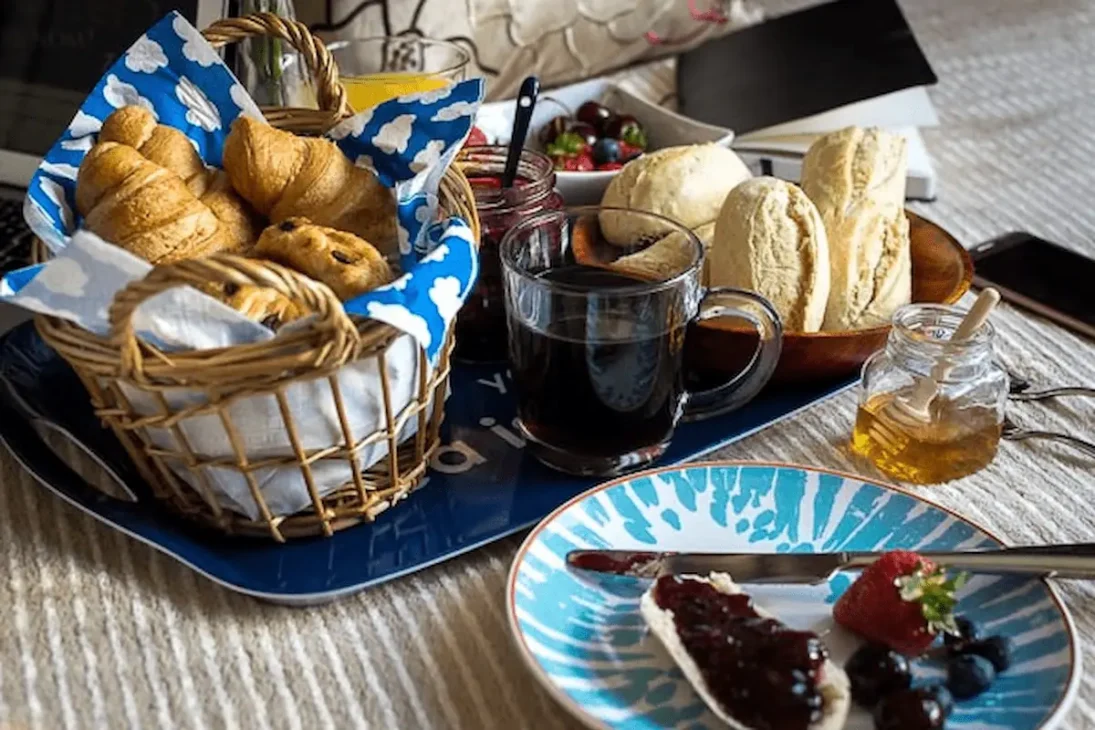
Le Petit Déjeuner, meaning “the little breakfast,” is France’s traditional morning meal. Typically enjoyed at home or in local cafés, especially in Paris and other bustling cities, it features simple fare: a croissant or buttered baguette with jam, accompanied by café au lait (coffee with milk), hot chocolate, or tea. French breakfasts are simple, yet they reflect care in ingredient selection and preparation, such as high-quality butter, fresh bread, and artisan jams.
Before the 19th century, morning meals were minimal, often just buttered bread dipped in milk or a light beverage. Viennoiseries, French baked goods made from yeast-leavened dough, like croissants and pain au chocolat, were introduced from Austrian kipferl by August Zang, an Austrian baker who popularized these pastries in Paris. This addition brought a flaky, buttery indulgence to the table, transforming breakfast into a deliberate, café-centered ritual.
Today, Le Petit Déjeuner remains a reflection of French culinary culture. Its elegance comes from the skill and quality of its pastries, while its mindfulness emerges from the slow, intentional enjoyment of each bite. Far from being rushed, this breakfast celebrates simplicity, craftsmanship, and the pleasure of starting the day thoughtfully.
5. Mexican Breakfast – Chilaquiles

Chilaquiles are a beloved Mexican breakfast made from lightly fried tortilla chips simmered in red or green salsa, then topped with cheese, crema, onions, and often a fried or scrambled egg. Regional variations might include shredded chicken, beans, or avocado, reflecting local tastes and household traditions. Served in family kitchens or small eateries called fondas throughout Mexico City, chilaquiles show how humble ingredients can be transformed into a flavorful, comforting meal.
The dish’s origins trace back to pre-Hispanic Mesoamerica. Aztec cooks, members of an ancient Mexican civilization, repurposed stale tortillas by frying them and soaking them in chili-based sauces, demonstrating creativity and resourcefulness in everyday cooking. The name comes from Nahuatl, the language spoken by the Aztecs, possibly from chīlāquīlli, meaning “something in chile.” Later, during the colonial period, the introduction of European ingredients such as dairy and onions enriched the dish, creating the chilaquiles familiar to modern diners.
Chilaquiles are more than a breakfast dish; they embody culinary creativity, family traditions, and communal dining. They are popular for weekend brunches or as a hearty remedy after celebrations. Their adaptability, whether served with eggs, chicken, or mole (a rich Mexican sauce made with chili, tomatoes, and a variety of spices), keeps chilaquiles central to both home cooking and restaurant menus, showcasing Mexico’s vibrant culinary identity.
6. Indian Breakfast – Dosa, Paratha, and Idli
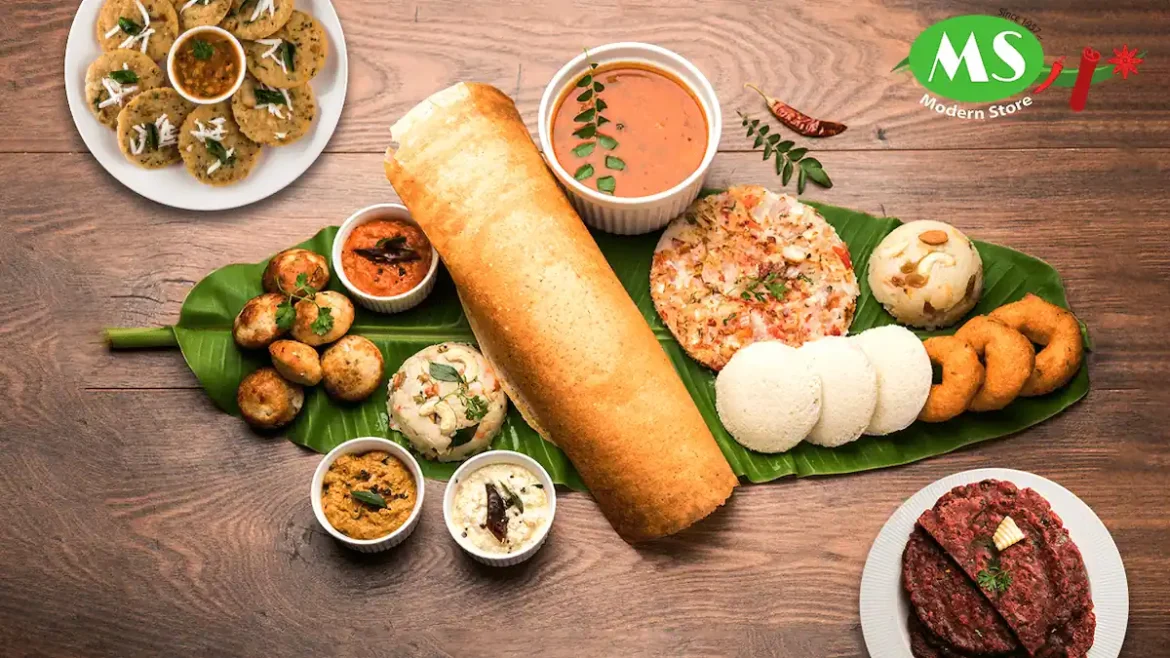
Breakfast in India showcases the country’s regional diversity and culinary richness. In the South, dosas, thin, crispy crepes made from fermented rice and lentil batter, are often served with chutneys (spiced condiments) and sambar (a tangy lentil and vegetable stew). Soft idlis, steamed rice cakes, provide a lighter, mildly tangy option that is easy to digest. In the North, mornings favor parathas, stuffed flatbreads filled with spiced potatoes, paneer, or vegetables, served alongside creamy yogurt and tangy pickles. South Indian breakfasts are tangy and savory, while northern ones are hearty, mildly spiced, and comforting, reflecting local ingredients and cooking traditions.
Historically, breakfast as the first meal of the day was not common in India. Until the 14th century, the main meal was usually eaten at midday, with only occasional light suppers at night. The concept of a morning meal gained importance in the 19th century, influenced by early employment schedules and European customs introduced through the East India Company, which emphasized structured meals and punctuality.
Today, dishes like idli-sambar, dosa, and paratha have transcended their regional origins. Idlis and dosas are gentle, tangy, and easy to digest, making them ideal “anytime” meals, while parathas provide hearty, savory comfort. Enjoyed at homes, street stalls, office canteens, and even train journeys, these breakfasts highlight India’s culinary adaptability, regional pride, and the cultural significance of the morning meal.
7. American Breakfast – Pancakes, Eggs, and Bacon

Breakfast in the United States is as diverse as its regions. In the Northeast, New York diners serve hearty plates of eggs, bacon, and toast, while in the South, such as Georgia, they offer grits and biscuits with gravy. In the Midwest, pancakes topped with butter and syrup are common in Illinois, whereas the Northwest, including Washington state, highlights smoked salmon and eggs. Meanwhile, the Southwest, like New Mexico, is known for huevos rancheros and breakfast burritos. These meals are often accompanied by coffee, reflecting the country’s blend of comfort and convenience.
The modern American breakfast took shape during the 19th and 20th centuries, shaped by farming communities that needed calorie-rich meals to fuel long workdays. As diners, packaged foods, and restaurant culture expanded, breakfast became not only practical but also a moment of enjoyment, showcasing local ingredients and familiar flavors.
Today, American breakfasts highlight variety, indulgence, and accessibility. From a quick bacon-and-egg combo to elaborate pancake feasts with syrup and butter, these meals illustrate America’s love for hearty, flavorful food and its adaptability in meeting diverse tastes. Whether enjoyed in a bustling diner or at home over morning coffee, breakfast continues to define a sense of routine, comfort, and culinary creativity in American life.
8. Filipino Breakfast – Silog Plates

A Filipino silog plate consists of sinangag (garlic fried rice), a fried egg, and a choice of meat such as tapa (cured beef), longganisa (sweet or garlicky pork sausage), or tocino (sweet cured pork). These dishes are quick, flavorful, and affordable, offering a hearty start to the day that highlights the Filipino love for bold, savory flavors.
Silog plates became popular in the late 20th century, especially in carinderias (small local eateries) and turo-turo stalls (where diners literally point with their fingers to select which dishes they want). This combination of rice, eggs, and protein was practical for workers needing energy, while the variety of flavors from sweet tocino to garlicky longganisa demonstrates a uniquely Filipino approach to simple ingredients.
Over time, silog transcended breakfast. Its name comes from combining the type of meat with “-silog” (from sinangag + itlog), creating terms like tapsilog (tapa + sinangag + itlog) and tocilog (tocino + sinangag + itlog). Today, silog dishes are enjoyed throughout the day, from early mornings to late-night cravings. They remain the most famous breakfast that every Filipino loves, enjoyed at home, in eateries, and during casual gatherings, reflecting the enduring popularity of silog in Filipino food culture.
9. Chinese Breakfast – Congee and Dim Sum
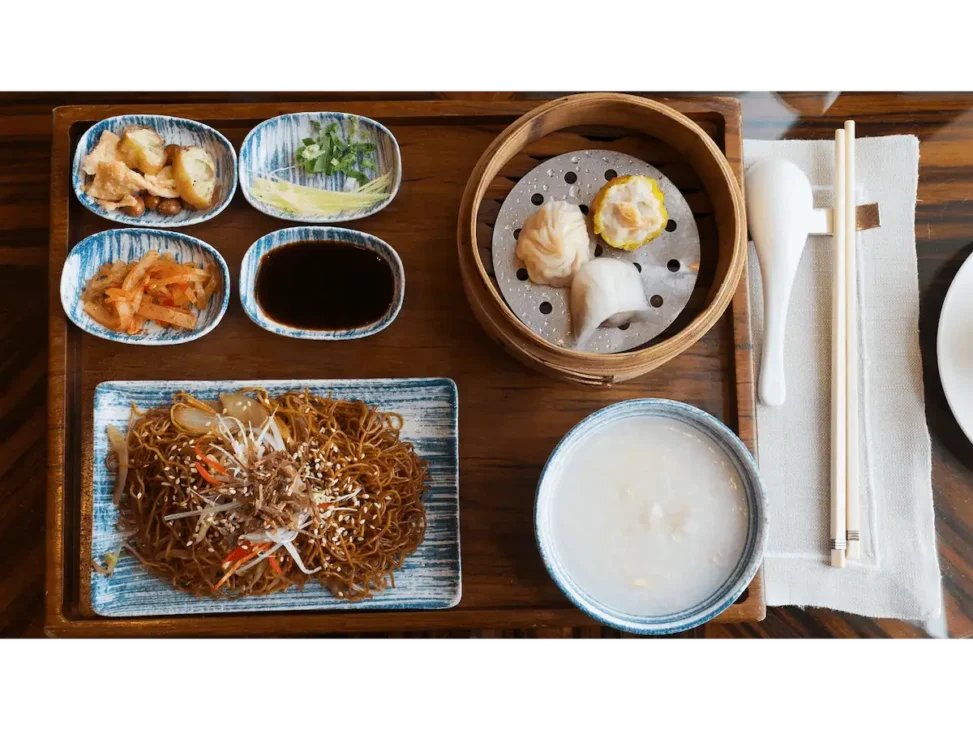
Congee, a soothing rice porridge, is often accompanied by pickles, tea, or steamed buns. Dim sum, a variety of bite-sized dumplings and delicacies, is designed for sharing. Together, they highlight China’s tradition of shared meals, emphasizing nourishment and the joy of gathering with others.
Congee’s origins trace back to ancient China as early as the Zhou dynasty around 1000 BCE. People valued it for its simplicity and ability to sustain people across social classes. Dim sum emerged in 19th-century Cantonese tea houses as part of the yum cha tradition, a custom of enjoying tea alongside small dishes evolving into a social brunch culture where friends and families gather over steamed delicacies.
Today, congee remains a comforting staple in households throughout China and abroad. Dim sum has become a global culinary experience, showcasing the variety, skill, and cultural richness of Chinese breakfast traditions.
10. Ethiopian Breakfast – Injera, Firfir, and Traditional Sides
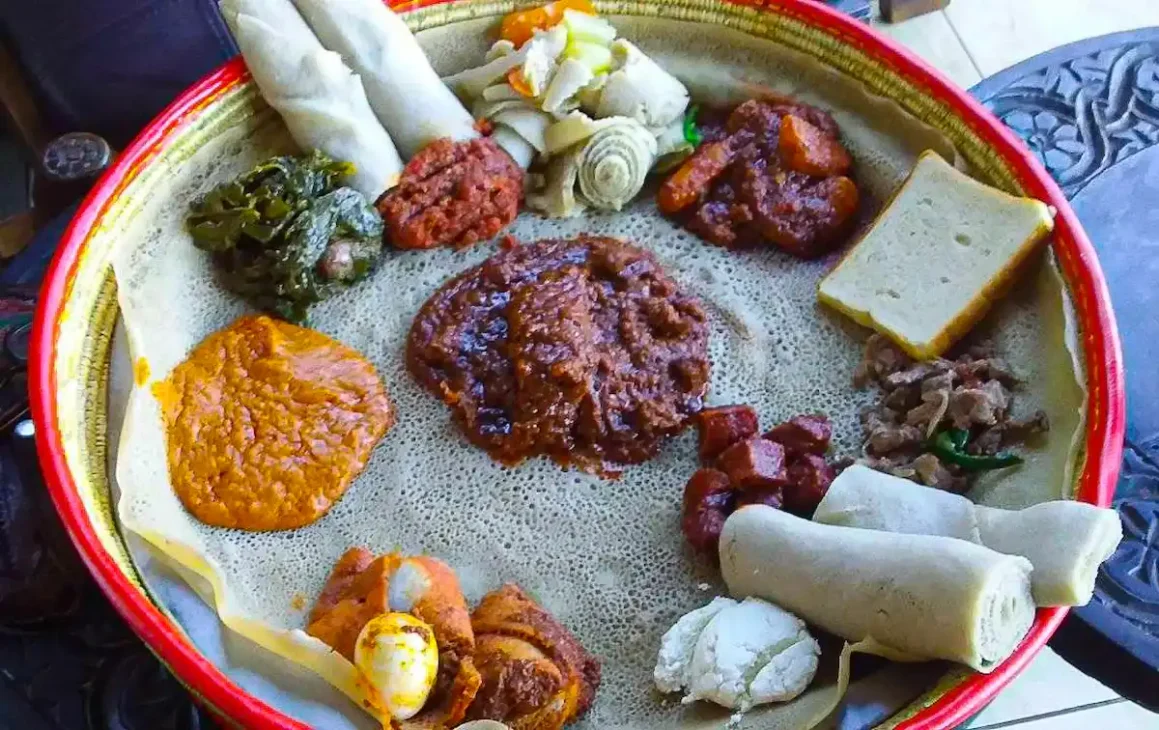
In Ethiopia, a typical breakfast often features injera (a spongy, sourdough flatbread made from teff flour) paired with firfir (spiced, shredded injera mixed with clarified butter and berbere, a blend of chili, garlic, ginger, and other spices) and accompanied by sides such as scrambled eggs, local cheeses like ayib, lentils, and fresh vegetables. What makes this breakfast unique is the communal, hands-on eating style: injera serves as both plate and utensil, used to scoop up the various dishes, creating an interactive and tactile dining experience.
Ethiopian breakfasts are deeply rooted in local ingredients and culinary traditions. Firfir’s bold spice and the tangy, slightly sour flavor of injera provide a distinctive taste profile, while ayib and fresh vegetables balance the meal. Eating with hands is not just practical but also culturally significant, emphasizing sharing, community, and mindfulness in dining. Served alongside freshly brewed Ethiopian coffee, these meals exemplify how breakfast can engage all senses while connecting people through tradition and hospitality.
Today, Ethiopian breakfasts are enjoyed from bustling cafés in Addis Ababa to family kitchens at home. They remain a beloved daily ritual, celebrated for their bold flavors, hands-on experience, and the way they reflect Ethiopia’s unique culinary identity.
International Breakfast Foods: A Global Taste of Culture
Breakfast offers insight into a community’s culture, local customs, and daily routines. From the leisurely tables of Turkey to the bold, savory flavors of the Philippines, international breakfast foods showcase how communities nourish themselves, honor traditions, and foster connection. Next time you sit down for your morning meal or are planning to travel abroad, you’ll now have an idea of what breakfast to expect.
What’s your favorite breakfast, something classic from home or an international dish you’ve tried (or are curious to try)? Share your pick and join the conversation about the meals that start our days best.
FAQs About International Breakfast Foods
1. What are international breakfast foods?
They are morning meals from around the world that reflect local ingredients, traditions, and culture.
2. Are international breakfast foods healthy?
Many are balanced with vegetables, grains, and protein, though some dishes can be richer or indulgent.
3. How can I try international breakfast foods at home?
You can recreate them using local ingredients, for example, making shakshuka (a tomato-and-egg dish) from the Middle East, or firfir with injera from Ethiopia.
4. Why do international breakfast foods vary so much?
They evolve based on geography, climate, culture, and daily routines, making each country’s breakfast unique.
5. Can international breakfast foods influence local menus?
Yes! Dishes like Turkish spreads, Japanese asagohan, or Filipino silog are now appearing in cafés worldwide, introducing global flavors.


